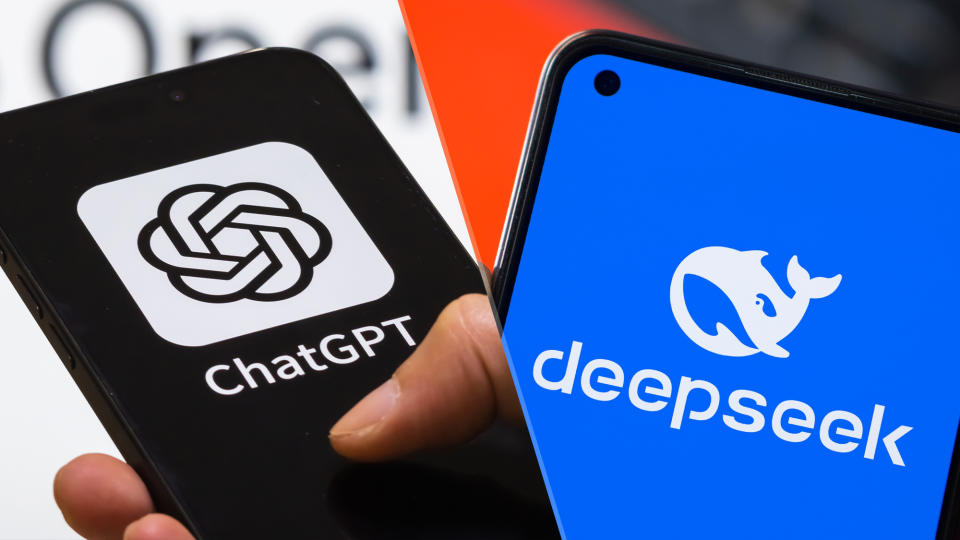
DeepSeek, launched in 2023, has already started making waves in AI development, particularly in the area of open-source large language models. The free chatbot app launched by DeepSeek topped the US app store charts within two weeks of its launch, making a strong mark in the generative AI sphere.
Apart from this, DeepSeek released its R1 large language model (LLM) in January 2025, selling for much less than competitors’ models. This proved to be a threat, erasing nearly $1 trillion in market capitalization for firms like Nvidia, Oracle, and Meta.
Moreover, DeepSeek has also offered free use of the R1 models to the public under an open-source license.
As per early 2025 reports, DeepSeek surpasses more than 33.7 million active users globally, making it 4th most app with the maximum active users.
Although the DeepSeek models can create any type of content, it highly depends on the quality of prompts we input. Why? Because it helps the platform generate accurate analysis and provide content based on your requirements.
“The right prompt ensures better results, maximizing its efficiency to the core.”
Just like the SEO prompts for ChatGPT, we have created before, some important DeepSeek model prompts are to be highlighted and discussed so that you are able to take full advantage of the model.
But first, let us introduce you to the concept of DeepSeek and how it generates content on SEO objectives in general.
Defining DeepSeek AI: Prompts and Capabilities
DeepSeek AI is an advanced AI platform that uses NLP and large language models (LLM) to optimize SEO content strategies and keyword analysis to improve your rankings on the SERP.
DeepSeek focuses on developing open source LLMs. From the time the company came up with its first model in 2023, there has been continuous modification along multiple lines of its core LLM and variations there. But, the company gained international fame in January 2025 after the release of its R1 reasoning model.
The news is also gaining attention from major media because it is claiming that it has been trained at significantly lower cost than $6 million, contrasted with OpenAI’s $100 million for GPT-4.
The company provides multiple services for its models, including a web interface, a mobile application and API access.
- Creating Content: It produces search engine-optimized content that has targeted keywords and structures.
- Keyword Research: It helps in analyzing the trends and suggests keywords performing highly while with low competition.
- Content Personalization: Tailors content according to user intent to better engage.
- Competitive analysis: Looks for the strategies of competing companies and identifies content voids.
- On-Page SEO: Optimizes meta tags, headers, and internal links to increase on-page SEO.
- Performance Tracking: Monitors rankings and traffic and also helps in giving insights regarding improvement.
This is why more than 42% of the startups have already started adopting DeepSeek in their operations.
Image Source: Yandex.com
Instructions To Create SEO-Friendly DeepSeek Prompts
DeepSeek AI generates outcomes based on the quality of input provided when specifying the prompt. These instructions will show users how to create better DeepSeek prompts:
1. Recognizing User Intent
- Identify the audience and their needs accordingly.
- Find intent: is it informational, navigational, commercial, or transactional?
- Make your prompt keywords align with terms that the searcher would likely employ.
2. Use Relevant Keywords
- Primary Keyword: Keep the main keyword flowing naturally in the prompt.
- Secondary Keywords: Include terms related to your area to widen the topics around which people will search.
- Long tails– Match that of a specific search query using long-tail keywords.
- Keyword stuffing is a bad practice; it needs to flow naturally.
Example:
Instead of AI content generation, say, “How to use AI for high-quality content creation?”
3. Structure the Prompts Well
- Clearly, briefly, and specific: Keep them clear, concise, and specific.
- To maximize response and minimize possible thought on the part of the user, the question should be framed as
Example: Generate an SEO-friendly blog post on AI in digital marketing of 1500 words with headings, subheadings, bullet points, etc.”
4. Using SEO Elements
- Title Optimization: While constructing the content, apply H1, H2, H3 as possible.
- Meta Description: An SEO-friendly one-sentence summary that must strictly reside within 150-160 characters.
- Linking Internally and Requesting Suggestions: Proposes related topics associated with linking within themselves.
5. Check Readability and Engagement
- Keep the language simple and human to better analyze the commands.
- Deep concepts should instead be bulleted or broken down into smaller paragraphs.
- Use a call to action (CTA) to incite engagement.
Following are some of the categories for which the prompts designed by DeepSeek are SEO oriented:
Deepseek Prompt for SEO Content
1. Prompt For Guest Post Articles
A guest post needs to be well-researched and insightful for the readers in the subject matter of the website. Additionally, it should serve the purpose of the search engine optimization criteria.
- “Please write a guest blog on [topic] targeted to [audience]. It needs to be insightful and complete with expert opinions; use the keyword phrase ‘[‘target keyword’]for its maximization.”
- “Help me create a thought-leadership guest post on [topic] using case examples from real life and actionable, even more compelling calls to action.”
- “Write a guest article by comparing [Product A] vs [Product B], bringing out the key SEO advantages, use cases, and success stories from customers.”
- “Write a 1500-word guest post covering ‘[topic]’ using SEO best practices, internal linking proposals, and keyword optimization.”
2. Prompts For SEO Blogs
SEO blogs are fun and informative at the same time they have to be optimized for ranking on the search engines. It should have headings, subheadings, FAQs, and internal linkings.
- “Write a detailed blog post on ‘[topic]’ with an engaging introduction, structured subheadings (H2/H3) and SEO-friendly formatting.”
- “Write a listicle blog on ‘Top 10 [topic]’ with keyword optimized headings, expert insights and internal links.”
- “Write a comparative blog on ‘[Topic A] vs. [Topic B]’ that carries SEO-rich nuggets, data-driven insights and well-structured formats.”
- “Create a problem-solution blog addressing ‘[pain point]’ and detail it with expert suggestions, SEO best practices and relevant CTAs.”
3. Website Content Prompts:
Website content must be clear, concise, succinct, and equipped with the right keywords to improve conversion and the user experience.
- “Create homepage content for a [business type] website. Also, make a strong USP, clear CTAs, and use SEO best practices.”
- “Composed an SEO-friendly About Us page for [business name], emphasizing the mission, unique values, and selling propositions.”
- “An engaging service page for ‘[service name]’ using keyword rich content for search and conversions.”
- “Generate structured FAQs with Schema Markup for [business type] websites.”
- “Write a product description for [product name] well convincingly with SEO keywords and strong CTA.”
4. Ad Copy (Google Ads, Social Media, PPC, Display Ads)
Ad copy must be short, persuasive, and action-oriented to convert as many clicks as possible.
- “Design a compelling Facebook ad for [product/service] having great hook, concise copy, strong CTA.”
- “Generate a LinkedIn ad copy promoting the service [B2B] with a professional tone and compelling value proposition.”
- “Write a persuasive meta title and description for a landing page about ‘[topic]’ to improve SEO and CTR.”
- “Develop An Instagram ad caption for [product] which has emotional appeal, urgency, direct CTA.”
5. Prompts for Search Engine Optimization
For use in different types of content, take advantage of these prompts for the enhancement of their SEO.
- “Now, rewrite this content with semantic keywords contained in LSI with regards to ‘[topic]’ while remaining readable.”
- “Write the SEO-title and meta description for a blog about ‘[topic]’ while making sure to keep it below 160 characters.”
- “Create an FAQ section schema markup-ready for a webpage about ‘[topic]’ for better search rankings.”
- “Write an engaging introduction to a blog for ‘[topic]’ that increases the time spent reading by the audience as well as hooks them immediately in the first 100 words.”
- “Generate long-tail keyword variants out of ‘[primary keyword]’ and merge them into the blog post naturally.”
Lets now discuss with an example of SEO friendly blog prompts and see how well DeepSeek works:
Step: 1 Keyword Research Prompt
Your content is of no relevance without the use of proper keywords. However, finding the right, high-ranking keywords for your website is not as easy as it sounds. So, if you are looking to generate a keyword for wireless headphones, you can enter a prompt like:
Analyze the keyword “wireless headphones” and provide me with 20 tail keywords which have low competition but search volume must be high. Also, include volume, and competitive score for better content optimization.
Here, you can also make modifications by writing more ling keywords like “best budget wireless headphones”, and “wireless headphones for smartphone”. Always focus on less competition but high-volume keywords for better content ranking.
Step 2.Prompt For Content Creation
First of all, you need to highlight your requirements and make the DeepSeek model understand what you want. You can enter a prompt like:
Write a 1000-word SEO-friendly blog on the best wireless headphones in 2025. The content must contain the keywords “best wireless headphones” and “best wireless headphones to buy in 2025.”
- Prompt for blog title: Write 5 engaging blog title ideas for the best wireless headphones in 2025. The titles should be SEO-friendly and must contain the keywords ‘best wireless headphones’ and ‘best wireless headphones to buy in 2025.
- Prompt to write the blog based on title and outline: Create a detailed blog outline for a 1000-word blog on the best wireless headphones in 2025. The outline must be eye-catching with key factors to consider when buying wireless headphones. Ensure the keywords ‘best wireless headphones’ and ‘best wireless headphones to buy in 2025’ are naturally incorporated keeping keyword density between 7-9.
However, you can also make adjustments to the initial draft in real time. The DeepSeek model enables real-time changes that let users change their document sections and insert additional details while expanding particular aspects.
The system accepts instructions such as these:
- “Continue with a few more supporting words.” The model generates short supplemental details in response to this instruction.
- The introduction needs an engaging text rewrite. This helps improve reader engagement.
- The text should have its list transformed into a comparison table. This ensures better content structuring.
Step 3: User Intent Prompt
Understanding what the user wants is very important in creating powerful SEO content strategies. For example, creating a guide to “buying wireless headphones” for informational intent or wireless headphones product pages for transactional intent. For this, you need to enter a prompt like:
“Help me in identifying the search intent behind “wireless headphones” and also provide me with content ideas that align with transactional or informational intent. Also, give me ideas for blogs and product pages”
Image Source: DeepSeek Interface (Screenshot)
Step 4: Prompt For Content Personalization
With such a diverse competition, you may not get the exact keyword you are looking for. To make your content more personalized you can ask DeepSeek to provide content based on your personal preferences. You can enter prompts like:
“I am a gym freak, so keep your target audience as fitness enthusiasts and give me an interesting blog on the best headphones in 2025. Maintain a casual tone and hit the pain points of the customers”
Step 5: Prompt For Competition Analysis
To rank better on the SERP, it’s important to know who your competitors are, their strengths, and weaknesses will help you get better insights and improve your SEO content strategy. To further strengthen your SEO strategy for your keyword wireless headphones, you can provide a prompt as:
Give me a detailed comparison of my keyword, “wireless headphones” and tell me 3 competitors using the same keyword. Help me in rectifying content gaps, and areas of improvement and suggest similar topics to rank better on the SERP.
Image Source: DeepSeek Interface (Screenshot)
Step 6: SEO Optimization Prompt
Once you get your desired content on the table with all keywords and other general requirements fulfilled, it is time to make it optimized for On-page SEO.
For that, you need to enter the prompt as:
Can you optimize this content for On-Page SEO including metatags, alt-to-text images, internal links, and CTA? Keep the focus on my keyword “wireless headphones”
This prompt mainly focuses on optimizing keywords to make it SEO-friendly while keeping the essence of the content the same. However, you can add further prompts like:
- Think like an SEO expert and make this content relatable for On-Page SEO.
- Do not overstuff the keyword; keep the keyword density between 6-7 times depending on the keyword type.
Step 7: Performance Tracking Prompt
Well! It is one of the most important prompts to check the credibility of DeepSeek models. This prompt will tell you the performance of your posts, user engagement, and overall traffic to your SEO content. Here you can enter prompts like:
“Assist me in tracking the performance of my blog “Best wireless headphones in 2025”. Please monitor rankings, organic traffic and user metrics for the next 30 days” Do provide me additional recommendations for improving these metrics”.
Conclusion
These prompts were just to give you an idea of how DeepSeek AI can help you automate your SEO content strategy in 2025. However, it also depends on your prompt because the better the prompt, the better results you get.
However, for SEO-related strategies, it is always better to partner with the best SEO agency that knows various marketing tactics and AI tactics to improve your online visibility. SEO companies like ResultFirst are well versed with ChatGPT and DeepSeek models to improve content strategies and boost search rankings effectively.


